This post is one in a series following six brewers collaborating to each make a small adjustment to a single recipe in order to improve it, then pass it along to the next brewer. We hope to learn more about the art of recipe creation as we see how other brewers approach the same recipe. The rest of the series can be found here.
Author: T. Bowen
Brew Day
To keep the crew on schedule, my recommended brew-by-date was July 13. But I wasn’t too worried about starting a day late since I’ve used WLP004 quite a bit (it’s essentially my de facto house stout yeast), so I’m familiar enough with how it ferments to be satisfied with my adjusted timeline. Per the usual, my brew day was Sunday, July 15. I started as early as possible that morning because I was not looking forward to standing around a hot burner for a few hours due to how hot it is right now. Suffice to say, it was a drastically different brew day weather-wise than my first iteration brewed back in January. I’ve also moved my setup to the driveway as opposed to the backyard because the flies are miserable this year and my backyard is a wasteland of old leaves and crap for flies to hide in.
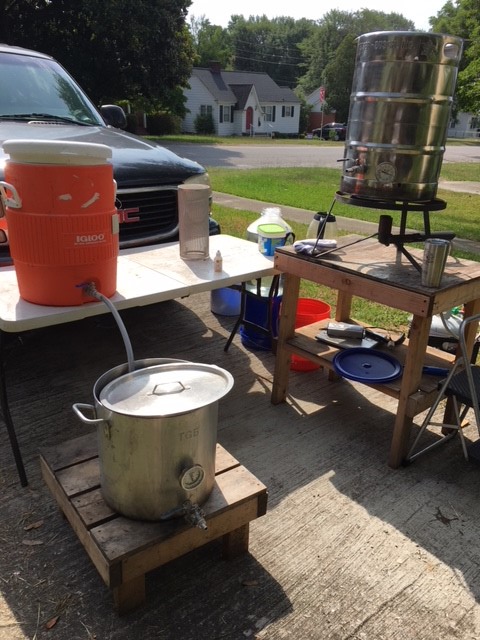
After tasting Iteration 7, I had some initial thoughts on where I wanted this beer to go. Of note, I enjoyed Iteration 7 much better than Iterations 1 and 2 (the only others I had tasted). Not that the earlier ones were bad, I just felt this beer has really started to come together nicely and it’s kind of cool to see the community collaboration thing happening before my eyes (and palate). But I was fairly certain I knew what I wanted to add/change before I even looked at the latest recipe. I also opted to not review recipes from other iterations; I wanted to formulate my new iteration with a completely open mind without influencing my decisions based on previous recipes that I never got to taste.
After getting everything set up, I proceeded to mill my grains while my strike water was heating. I targeted a strike water temperature of 165°F to reach my target mash temperature of 154°F. This required a watchful eye on the strike water because I realized two brews ago that the thermometer on my HLT is reading about 6°F lower than actual, and I haven’t gotten around to calibrating it. Nonetheless, I heated the strike water to 165°F, ran off to the mash tun, and stirred in the grains like a mad man to break up any dough balls. I checked temp—right on the money—and put her to bed for 60 minutes.
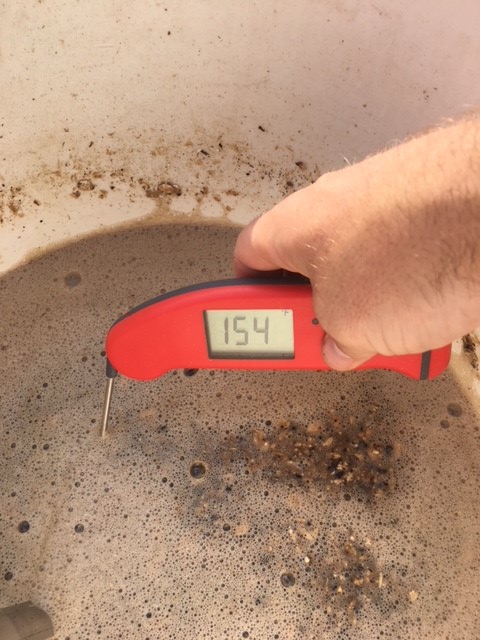
During the mash, I took time to weigh out my hop additions for the boil and started heating my sparge water.
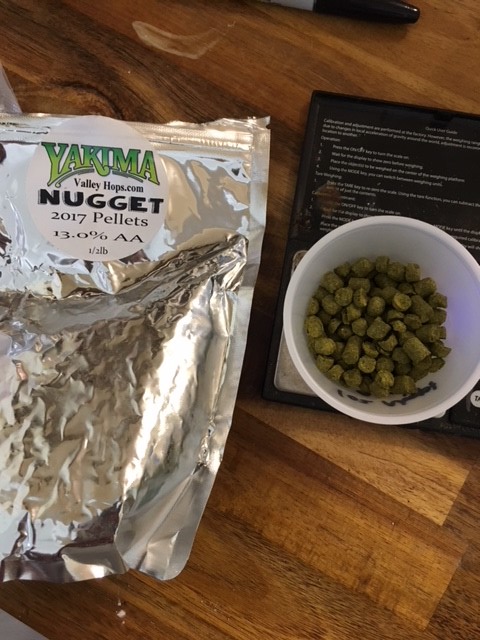
This is going to sound insane, but for the longest time (really since I started), I’ve never touched the mash tun until the mash was over. No intermittent stirring, temp checks, nothing. But recently I’ve started doing a temp check and stir of the mash halfway through. So, at 30 minutes, I opened the tun for a stir and checked the temp.
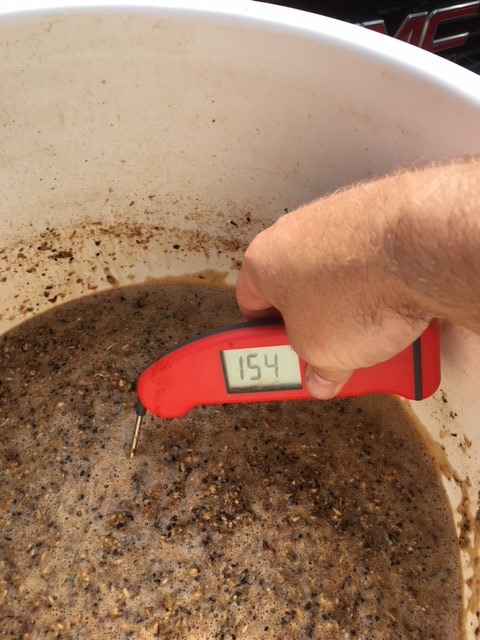
It was still dead on my mash temperature of 154°F. It’s always a good feeling when you’re getting into the thick of a brew day and everything is going perfectly. I let the mash finish out and decided to take a final temp of the mash.
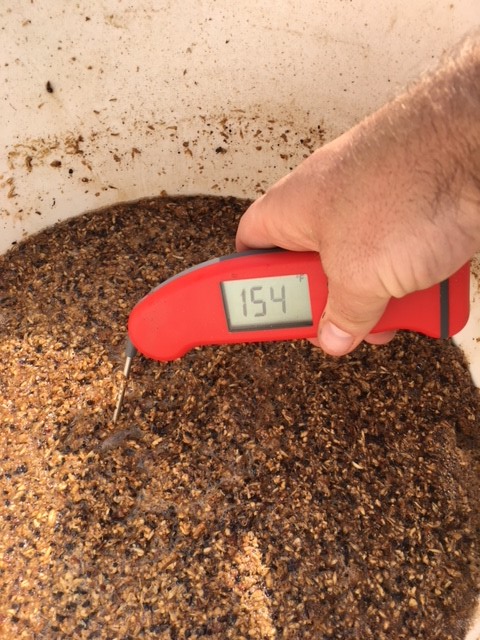
Well that is nice! Usually I can hold temps fine and maybe lose a degree. I can’t remember the last time I lost zero heat. I guess that’s one advantage of brewing in the sweltering heat. I then proceeded to vorlauf and sparge and hit my desired preboil volume of 7 gallons. The boil was uneventful, as boils often are. I had a minor hiccup when my propane ran out about halfway through the boil. Thankfully, my backup tank still had some juice to squeeze, and I was able to switch out the tanks and get the burner going again all in about two minutes. I never even really lost the boil.
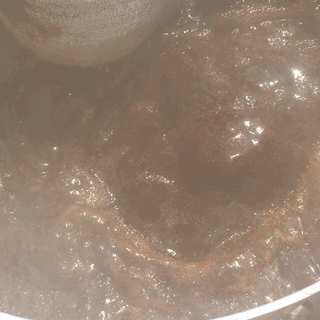
Following the boil, I began chilling while I pulled a sample from the kettle to chill for a gravity check. Chilling proceeded nice and slowly due to the ridiculous temperatures and the fact that my groundwater is around 80°F at this point. I augment my chilling by pumping ice water through my immersion chiller with a simple pump. Even with the ice water, chilling took 45 minutes or so. I can’t wait to get a pump!
I nailed my post-chill volume of 5.25 gallons and got exactly 5 gallons in the fermenter. After racking to the fermenter, I tucked it away for an hour or two while I cleaned up to let it chill a few more degrees before I pitched my WLP004 starter. At this point my gravity sample had chilled sufficiently to drop in the hydrometer. In keeping with the spirit of this collaboration and the parameters of the recipe, I had an estimated OG of 1.064. So imagine my surprise when I saw this…
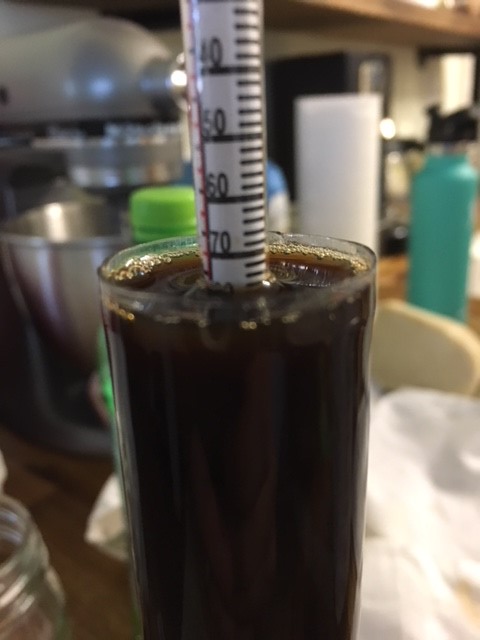
1.075?! Ok, something is off here. Sample temperature? Nope, right around calibrated temp of 60°F. Hydrometer is going wonky? Nope, double checked the hydrometer with distilled water and it’s pretty spot on. So I started to dig in and figure out why I overshot my gravity by 10ish points.
I use Beersmith2 for all my recipe design. I have multiple equipment profiles dialed in, as well as mash profiles. Suffice to say, I know my system very well and since I finally properly set up Beersmith earlier this year, I’ve been very consistent with volumes, gravities, etc. My efficiency setting is 67% and I consistently hit my numbers with this efficiency. So I went back to my laptop and plugged in the actual OG and it showed an 80% efficiency. How does that even happen? I should also note at this point that I had recently gotten a new grain mill. This was my first mill and I used to always get it milled in the shop. But, this was the fourth batch I had brewed with this new mill, and other than a one or two point bump in efficiency, the first three batches with the new mill were dead accurate. Also, I set the gap on my mill with feeler gauges and following this brew day, I verified the gap had not changed. Suffice to say, I have no idea how this happened. Everything else in my equipment and process was ceteris paribus. Oh well. There is one final possibility…on the day I went to pick up my grains from my LHBS, my usual guy was out of town and I had someone else weigh out my grains. He asked for clarification at least once or twice on some amounts, and with a few of my grain weights being “ounce-specific,” I suppose it’s possible he gave me more of something. I’ll add this to the list of myriad reasons why I need to start buying grain in bulk.
I hit the wort with oxygen and pitched a 1.8L starter of fourth generation WLP004. [Note: I use liquid yeast 99% of the time. Ergo, I overbuild all my starters and harvest from the starter pre-pitch. I continue to use the same source strain until things start skewing too much or the yeast starts attenuating less and less. The last time I used this 004 was in April. That was, of course, 3rd generation, and it still fermented out fine with no off flavors and attenuated 86%, so I was confident using this 4th generation for this stout.]
I reached out to Chris for his advice on how we wanted to proceed with this higher gravity. We discussed topping off the fermenter with water to get down to the OG I was shooting for. I was fermenting this batch in my 7 gallon Fermonster, so I certainly had adequate headspace. However, ultimately I decided to leave it as is. The primary reason for this was I did not want to dilute the beer, particularly the hop presence and bitterness. I ran the numbers, and to get down to 1.064, I would need to add roughly 0.86 gallons of water, which I felt would dilute the beer more than I was comfortable with. The hop profile and bitterness on this beer is borderline perfect for my palate, so I did not want to disrupt that. Ergo, what was planned to be a mid-5% ABV stout, could potentially end up a mid-8% ABV stout. As the saying goes, “waste not, lest ye be wasted.” Or something like that, right?
Recipe
Iteration 7 was far and away better than Iteration 1, which is saying a lot because Iteration 1 was a solid stout. One thing I felt was lacking back on Iteration 1 was hop presence, but the hops in Iteration 7 were much better. Pretty much spot on, in my opinion, so I knew I did not need to mess with the hops. Iteration 7 also had a great mouthfeel, big and creamy, which I attributed to the flaked barley. I love having a flaked adjunct in all of my stouts for exactly those reasons, so I knew I was not changing that. The deeper I got into Iteration 7, and the more I let it warm up, the more roasted notes came to the forefront. The beer had a solid roast backbone, but I wanted more chocolate; actually, I wanted a softer, rounder chocolate flavor to balance some of the roast. Ultimately, what I was seeking was more of a candy bar chocolate flavor, which led me to Pale Chocolate. Depending on the beer, I usually like to balance Chocolate Malt with Pale Chocolate. To me, Chocolate Malt has more of a roastiness associated with coffee, whereas Pale Chocolate tastes more like, well, chocolate. Put another way, Pale Chocolate has more of the candy bar chocolate flavor, and Chocolate Malt has more of that bittersweet baking chocolate flavor. With my end goal firmly decided, here’s what I came up with:
- Mashed at 154°F for 1 hour
- 68% 2-Row
- 10.2% Victory
- 7.5% Flaked Barley
- 7.5% Roasted Barley
- 5.1% Pale Chocolate
- 1.7% Chocolate
- Boiled for 1 hour
- 1 oz. Nugget (60 min) at 13% AA (44.3 IBUs)
- 1 oz. Centennial (5 min) at 9.9% AA (6.8 IBUs)
- Water Profile (ppm): [Black Full] Calcium (41); Magnesium (3); Sodium (29); Sulfate (37); Chloride (49)
- Pitched WLP004 (1.8L starter)
- OG (calculated): 1.064
- OG (actual): 1.075 (see above)
- FG (actual): 1.012
- ABV: 8.3%
Tasting
Iteration 8 poured dark black, with a thick, light tan head, with thick compact bubbles, almost like a nitro beer.
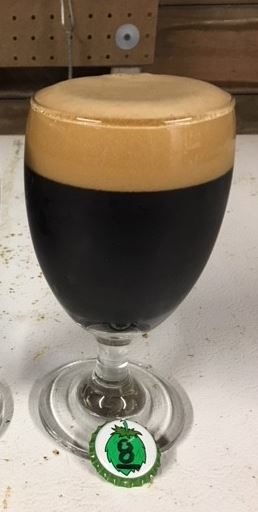
Iteration 8 has a nose that reminds me of bittersweet chocolate, much like a baker’s kitchen. The taste reminds me of toasted chocolate milk, if that’s even possible. I get a heavy dark chocolate mocha and some slight alcohol warming in Iteration 8, most likely due to the much higher ABV than Iteration 7. The foam in Iteration 8 persisted throughout the glass.
Overall, I’m fairly pleased with Iteration 8. I definitely hit the chocolate candy bar notes I wanted from blending Chocolate Malt with Pale Chocolate. It’s got a nice full mouthfeel that further accentuates the chocolate flavors. This is far from the perfect stout, but even still I had trouble deciding what I would change if I were to brew this again. One thing I would be interested in is how the beer would change with a different base malt. I would like to try this beer with Maris Otter for the base malt to boost some of the flavors and round out the base with some more bready thickness that I often get from Maris Otter. Outside of that, I would consider either subbing out Flaked Barley for Flaked Oats and increasing the amount, or simply bumping up the Flaked Barley. I’m certainly curious to see where this beer goes next. I think it’s very solid as is currently, and any changes moving forward may hinge on brewers’ personal preferences.
Recipe Progression
| Iteration 1 | Iteration 2 | Iteration 3 | Iteration 4 | Iteration 5 | |
| Base Malt 2-row | 80% | 80% | 80% | 72.5% | 69.2% |
| Specialty Malt 1 | 10% Victory | 10% Victory | 5% Victory | 10.8% | 10.8% |
| Specialty Malt 2 | 5% Roasted Barley | 5% Roasted Barley | 10% Roasted Barley | 4.4% Roasted Barley | 7.8% Roasted Barley |
| Specialty Malt 3 | 5% Carafa III | 5% Chocolate Malt | 5 % Chocolate Malt | 4.4% Chocolate Malt | 4.4% Chocolate Malt |
| Specialty Malt 4 | None | None | None | 7.8% Flaked Barley | 7.8% Flaked Barley |
| Specialty Malt 5 | None | None | None | None | None |
| 60 min. hop | Nugget: 47.7 IBUs | Nugget: 42.5 IBUs | Nugget: 47.7 IBUs | Nugget: 41.2 IBUs | Nugget: 41.5 IBUs |
| 5 min. hop | Willamette: 3.6 IBUs | Willamette: 3.3 IBUs | Willamette: 2.9 IBUs | Willamette: 3 IBUs | Willamette: 3 IBUs |
| Yeast | US-05 | US-05 | US-05 | US-05 | US-05 |
| OG | 1.054 | 1.060 | 1.045 | 1.065 | 1.064 |
| FG | 1.010 | 1.016 | 1.005 | 10.20 | 1.020 |
| ABV | 5.8% | 5.8% | 5.25% | 5.9% | 5.8% |
| Iteration 6 | Iteration 7 | Iteration 8 | |
| Base Malt 2-row | 69.2% | 69.2% | 68% |
| Specialty Malt 1 | 10.8% Victory | 10.8% Victory | 10.2% Victory |
| Specialty Malt 2 | 7.8% Roasted Barley | 7.8% Roasted Barley | 7.5% Roasted Barley |
| Specialty Malt 3 | 4.4% Chocolate Malt | 4.4% Chocolate Malt | 1.7% Chocolate Malt |
| Specialty Malt 4 | 7.8% Flaked Barley | 7.8% Flaked Barley | 7.5% Flaked Barley |
| Specialty Malt 5 | None | None | 5.1% Pale Chocolate |
| 60 min. hop | Nugget: 45 IBUs | Nugget: 44.3 IBUs | Nugget: 44.3 IBUs |
| 5 min. hop | Willamette: 3.6 IBUs | Centennial: 6.2 IBUs | Centennial: 6.8 IBUs |
| Yeast | White Labs Irish Ale Yeast (WLP004) | White Labs Irish Ale Yeast (WLP004) | White Labs Irish Ale Yeast (WLP004) |
| OG | 1.065 | 1.064 | 1.075 |
| FG | 1.018 | 1.021 | 1.012 |
| ABV | 6.2% | 5.6% | 8.3% |

Pingback: Stout: Tasting Iterations 7 & 8 | brewublog
Pingback: Stout: Iteration 9 | brewublog
Pingback: Stout: Tasting Iterations 8 & 9 | brewublog
Pingback: Stout: Iteration 10 | brewublog